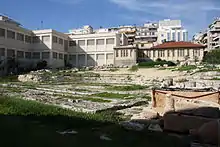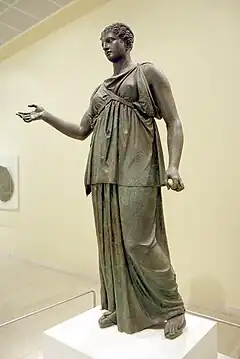
The Archaeological Museum of Piraeus contains mainly sculptures, discovered in Piraeus and in the area of the Attic coast from Bronze Age to Roman times,[1]
Collections

The museum's displayed objects are divided in sections:[2]
- Prehistoric collection (Mycenaean)
- Pottery collection
- Bronze statues
- A reconstruction of a typical Classical sanctuary (Cybele's)
- Classical gravestones
- Large funerary monuments
- Hellenistic sculptures
- Roman sculptures
The building
The old building of the museum (330 m2 [1]), which is currently used as a storage room, was built in 1935.[3] The new two-store building, which was inaugurated in 1981,[3] covers a total area of total 1.394 m2. Both buildings neighbour on the Zeas (Greek: Ζέα) ancient classical theater. In the near future, the theater site is going to be used as an open-air sculpture exhibition.[1]
Visitors information
The museum is accessible with the Athens metro or bus lines. It is 15-minute walk from Piraeus station and a couple minute walk from bus station. Moreover, it is a 5-minute walk from the area for the reception of Cruise ships of the Piraeus port.
Gallery
 Funerary relief for a girl, flanked by her parents (330/320 BC)
Funerary relief for a girl, flanked by her parents (330/320 BC) The Piraeus Athena, a classical-age bronze
The Piraeus Athena, a classical-age bronze The Piraeus Apollo, an archaic-age bronze
The Piraeus Apollo, an archaic-age bronze Copy of Piraeus Lion
Copy of Piraeus Lion Nude ephebe (2nd century CE), Roman copy after an original of the Polykleitan school
Nude ephebe (2nd century CE), Roman copy after an original of the Polykleitan school Bronze statue of a Piraeus Artemis. It dates from the mid-4th century and is attributed to the sculptor Euphranor
Bronze statue of a Piraeus Artemis. It dates from the mid-4th century and is attributed to the sculptor Euphranor Bronze tragic mask from the mid-4th century and is attributed to the sculptor Silanion
Bronze tragic mask from the mid-4th century and is attributed to the sculptor Silanion Remains of a colossal statue of Hadrian.
Remains of a colossal statue of Hadrian.
See also
References
- 1 2 3 Kornilia Axioti. "Hellenic Ministry of Culture Archaeological Museum of Piraeus" (in Greek). Hellenic Ministry of Culture. Archived from the original on 8 May 2007. Retrieved 2007-04-29.
- ↑ Ministry of Culture (Archaeological Receipts Funds), Archaeological Museum of Piraeus (brochure)
- 1 2 Steinhauer, George (2001). "The Archaeological Museum of Piraeus". John S. Latsis Public Benefit Foundation. Archived from the original on 2011-10-03. Retrieved 2011-03-16.
External links
![]() Media related to Archaeological Museum of Piraeus (Athens) at Wikimedia Commons
Media related to Archaeological Museum of Piraeus (Athens) at Wikimedia Commons